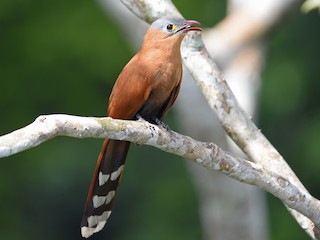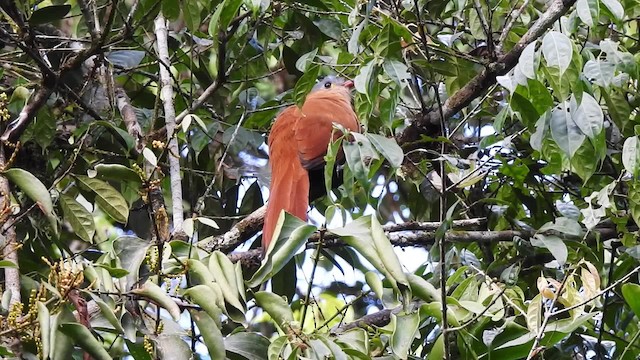Black-bellied Cuckoo Piaya melanogaster Scientific name definitions
- LC Least Concern
- Names (31)
- Monotypic
Text last updated January 4, 2014
Sign in to see your badges
Species names in all available languages
| Language | Common name |
|---|---|
| Afrikaans | Swartpenskoekoek |
| Bulgarian | Чернокорема кукувица |
| Catalan | cucut esquirol bec-roig |
| Croatian | crnotrba kukavica |
| Czech | kukačka černobřichá |
| Danish | Sortbuget Egerngøg |
| Dutch | Zwartbuikkoekoek |
| English | Black-bellied Cuckoo |
| English (AVI) | Black-bellied Cuckoo |
| English (United States) | Black-bellied Cuckoo |
| Estonian | ruske-oravkägu |
| Finnish | hunajakäki |
| French | Piaye à ventre noir |
| German | Schwarzbauchkuckuck |
| Japanese | クリハラリスカッコウ |
| Norwegian | svartbukgjøk |
| Polish | rudzianka krasnodzioba |
| Portuguese (Brazil) | chincoã-de-bico-vermelho |
| Portuguese (Portugal) | Chincoã-de-bico-vermelho |
| Russian | Чернобрюхая пиайя |
| Serbian | Crnotrba kukavica |
| Slovak | kukavka čiernobruchá |
| Spanish | Cuco Ardilla Ventrinegro |
| Spanish (Ecuador) | Cuco Ventrinegro |
| Spanish (Peru) | Cuco de Vientre Negro |
| Spanish (Spain) | Cuco ardilla ventrinegro |
| Spanish (Uruguay) | Pirincho de Monte Vientre Negro |
| Spanish (Venezuela) | Piscua Ventrinegra |
| Swedish | svartbukig gök |
| Turkish | Kara Karınlı Sincap Guguğu |
| Ukrainian | Піая червонодзьоба |
Piaya melanogaster (Vieillot, 1817)
Definitions
- PIAYA
- melanogaster / melanogastra / melanogastris / melanogastrus
The Key to Scientific Names
Legend Overview
Introduction
Despite its wide range over much of Amazonia, from eastern Venezuela and the Guianas south and west to eastern Peru and northern Bolivia, the Black-bellied Cuckoo is a rather poorly known bird in terms of its natural history. Given a reasonable view, it is easily separated from the much more ubiquitous and more familiar Squirrel Cuckoo (Piaya cayana), which often shares the same habitat as the Black-bellied Cuckoo. In addition to the all-dark belly, the present species also has a red bill, blue-gray cap and yellow ocular skin, bright chestnut upperparts, and otherwise orange-buff underparts. The Black-bellied Cuckoo is a generally uncommon bird, usually found at mid to higher levels in tropical forest zones, although it occasionally ventures into savanna woodland, and principally feeds on insects. Virtually nothing is known concerning the species’ breeding biology.
Identification
38 cm; 102 g. Adult rufous-chestnut above with light grey cap , throat and breast orange-buff, becoming black on abdomen and undertail-coverts, tail rufous with subterminal black band and broad white tip ; bare orbital skin pale blue, large yellow loral spot , iris dark brown to red, bill red, feet lead-grey to black. Juvenile similar.
Systematics History
Subspecies
Distribution
SE Colombia, E Venezuela and the Guianas S to E Ecuador, E Peru, N Bolivia and SC Brazil (Amazonia S to Mato Grosso).
General Habitat
Movements and Migration
Diet and Foraging
Insects, including grasshoppers, katydids, caterpillars
, beetles and ants. At two nests, incidental observations revealed that nestlings were mainly fed hairy caterpillars and, to a lesser extent, other arthropods: caterpillars included Automeris illustris, A. hamata and A. liberia, also a Dirphia sp. probably tarquinia (Hemileucinae, Saturniidae) and Amphonyx duponchel (Sphinginae, Sphingidae), while other prey included grasshoppers, crickets (Gryllidae), bush crickets (katydids, probably Pseudophyllinae, Tettigoniidae) and cicadas (Cicadidae), as
well as wandering spiders, probably a Phoneutria sp. (Ctenidae) (1). Feeds in canopy
.
Sounds and Vocal Behavior
Song a loud “jjit, jjit-jjit-jjit” ; scratchy descending “yaaaaa”, also a dry rattle.
Breeding
Two nests (both on an island in a river) with young being fed recorded in French Guiana in Aug and Nov (1) , respectively. Both were open, cup-shaped nests, approximately 250 mm wide and 100 mm deep, constructed of twigs, pieces of vine and dead leaves, and sited within dense tangles of vines, at c. 4 m and 8 m, respectively, above ground (1). Eggs white; 30 mm × 23 mm. Young, which have white knobs on the reddish palate (perhaps assist adults to place food in the chick’s open bill), are mainly fed during early morning (1). No further information.
Conservation Status
Not globally threatened (Least Concern). Generally uncommon and relatively little known. Despite occurrence in shrubby vegetation, species is reckoned to be sensitive to habitat disturbance.

- Year-round
- Migration
- Breeding
- Non-Breeding





















































